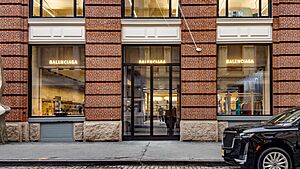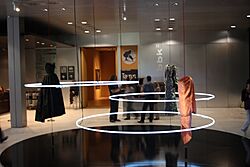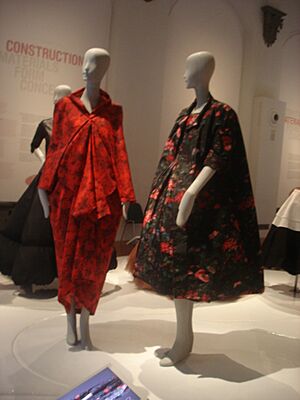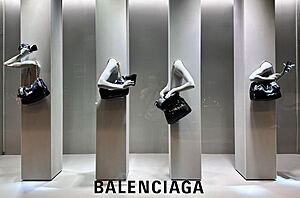Balenciaga facts for kids

Store in SoHo, Manhattan
|
|
| Subsidiary | |
| Industry | Fashion |
| Predecessor |
|
| Founded | 1919, in San Sebastián, Spain |
| Founder | Cristóbal Balenciaga |
| Headquarters |
Paris, France
|
|
Area served
|
Worldwide |
|
Key people
|
|
| Parent | Kering |
Balenciaga SA is a famous French luxury fashion company. It is known for designing and selling fancy shoes, handbags, and other accessories. Balenciaga also lets the company Coty use its name for perfumes. This brand is one of many luxury brands owned by a big French company called Kering.
The company was started in 1919 in San Sebastián, Spain, by a Spanish fashion designer named Cristóbal Balenciaga. As of November 2024, Gianfranco Gianangeli is the CEO of Balenciaga. Pierpaolo Piccioli is set to become the new creative director starting July 10, 2025.
Contents
Balenciaga's Story
Early Days and Moving to Paris
Cristóbal Balenciaga opened his first fashion shop in San Sebastián, Spain, in 1919. He soon opened more shops in Madrid and Barcelona. Even the Spanish royal family and rich people wore his clothes. But when the Spanish Civil War started, he had to close his shops in Spain. So, he moved to Paris, France.
In August 1937, Balenciaga opened his fashion house in Paris. His first fashion show there was a big success. People quickly saw him as a fashion leader. In just two years, he was praised for his new ideas. His designs became very popular.
During World War II, when Paris was occupied, Balenciaga's company kept running. This was partly because he had connections with the Spanish leader, General Francisco Franco. Balenciaga even designed clothes for Franco's family. His company was one of only 60 fashion houses allowed to stay open. He could also get materials from Spain, which were hard to find in Paris during the war. This gave him an advantage. However, he said he refused a request to move his company to Berlin.
New Fashion Shapes
After the war, Balenciaga's designs became smoother and simpler. He moved away from the "hourglass" shape that was popular then. He liked to change how clothes fit a woman's body. In 1951, he changed the shape of dresses by making the shoulders wider and removing the waistline.
He created many new styles:
- The tunic dress (1955)
- The chemise dress (1958)
- The balloon jacket (1953)
- The baby doll dress (1957)
- The cocoon coat (1957)
- The balloon skirt (1957)
- The sack dress (1957)
In 1959, he introduced the Empire line, with high-waisted dresses and coats. His way of changing the waistline is seen as his most important contribution to fashion.
In the 1960s, Balenciaga used heavy fabrics and detailed decorations. His clothes often had collars that stood away from the neck. He also made shorter "bracelet" sleeves. His designs were like sculptures and were worn by famous people. For example, he designed the wedding dress for Queen Fabiola of Belgium in 1960. Jackie Kennedy also loved his expensive clothes.
Famous Students
Many designers who worked for Balenciaga later started their own successful fashion houses. Some of them include Oscar de la Renta, Andre Courreges, and Emanuel Ungaro. His most famous student was Hubert de Givenchy. Givenchy was the only designer who supported Balenciaga in his disagreements with the fashion press.
Challenges with the Press
In 1957, Balenciaga decided to show his new collections to the fashion press just one day before they were sent to stores. This was different from the usual four weeks. He hoped this would stop others from copying his designs. The press found it hard to meet their deadlines, but Balenciaga and Givenchy stuck to their plan. This affected how much their work was covered in magazines. Some believed that rival designers copied Balenciaga's ideas and claimed them as their own. Because Balenciaga didn't care much about press coverage, people often didn't know.
In 1967, both designers went back to the traditional schedule.
Challenges with the Fashion Group
Balenciaga also didn't follow the rules of the main French fashion group, the Chambre Syndicale de la Haute Couture Parisienne. He was never a member of this group.
Cristóbal Balenciaga closed his fashion house in 1968. He passed away in 1972. The company then remained quiet until 1986.
From 1981 to 2010

Today, Balenciaga is owned by Kering. Nicolas Ghesquière was the head designer for women's and men's clothing for many years.
In 2002, Nicolas Ghesquière created a vest that looked very similar to one designed by Kaisik Wong in 1973. Ghesquière later said he had copied the design.
By 2005, Balenciaga was doing very well and attracting many famous customers. The company designed dresses for Jennifer Connelly and Nicole Kidman for the 2006 Academy Awards. They also made Kidman's wedding dress when she married Keith Urban. Singer Kylie Minogue wore Balenciaga dresses in her music videos and for her concerts.
Balenciaga is known for making bold, modern clothes that often look like art. Old Balenciaga clothes are very popular with fashion experts and Hollywood stars. Many celebrities like Sienna Miller, Jennifer Garner, and Chloë Sevigny have worn them.
From 2010 to Today
In March 2011, a special show called "Balenciaga and Spain" opened in San Francisco, USA. It showed 120 pieces from Cristóbal Balenciaga's career. Many designers said his influence was huge.
In June 2011, the Cristóbal Balenciaga Museum opened in Getaria, Spain.
In November 2012, Balenciaga announced that Nicolas Ghesquière was leaving after 15 years. Alexander Wang became the new creative director. He showed his first collection in February 2013.
In July 2015, Alexander Wang left Balenciaga after three years. His last show featured comfortable white clothes. In October 2015, Demna Gvasalia was chosen as the new creative director.
In October 2016, Cédric Charbit became the CEO. Under his leadership, Balenciaga grew a lot. The company made an estimated $2 billion in 2022.
In 2018, Balenciaga faced criticism in China after an incident at one of its Paris stores.
In April 2021, Demna Gvasalia showed his new collection. In August 2021, Justin Bieber became a new face for Balenciaga. In September 2021, the brand released sweatpants that looked like plaid boxers were sticking out, which caused some discussion.
In May 2022, Balenciaga announced it would accept payments using cryptocurrency.
In October 2022, Balenciaga stopped working with Kanye West due to his comments.
In December 2023, Balenciaga won an award from PETA. They won for making a completely vegan coat from a plant-based leather called Lunaform.
In May 2024, Balenciaga opened a new main store in Tokyo. In June, they opened their first store in Cancún, Mexico.
In November 2024, Gianfranco Gianangeli became the new CEO, taking over from Cédric Charbit.
Brand Ambassadors
In July 2023, Balenciaga announced its first-ever brand ambassadors: Isabelle Huppert and PP Krit Amnuaydechkorn. This was a new step for the company.
In November 2023, Michelle Yeoh became a Balenciaga brand ambassador.
In December 2023, Nicole Kidman was introduced as a new brand ambassador.
In January 2024, Kim Kardashian also became a brand ambassador for Balenciaga.
Support for Ukraine
In March 2022, during Paris Fashion Week, Balenciaga showed support for Ukraine during the conflict. Yellow and blue T-shirts, like the Ukrainian flag, were placed on chairs. Creative director Demna Gvasalia read a poem about Ukraine at the show. He said the show was about "fearlessness, resistance, and the victory of love and peace." The brand also gave money to the UN World Food Programme to help Ukrainian refugees.
Leaders at Balenciaga
CEOs
- 2016-2024: Cédric Charbit
- Since 2024: Gianfranco Gianangeli
Creative Directors
- 1919-1968: Cristóbal Balenciaga
- 1987-1992: Michel Goma
- 1992-1997: Josephus Thimister
- 1997-2012: Nicolas Ghesquière
- 2013-2015: Alexander Wang
- 2015-2025: Demna Gvasalia
- 2025-now: Pierpaolo Piccioli



